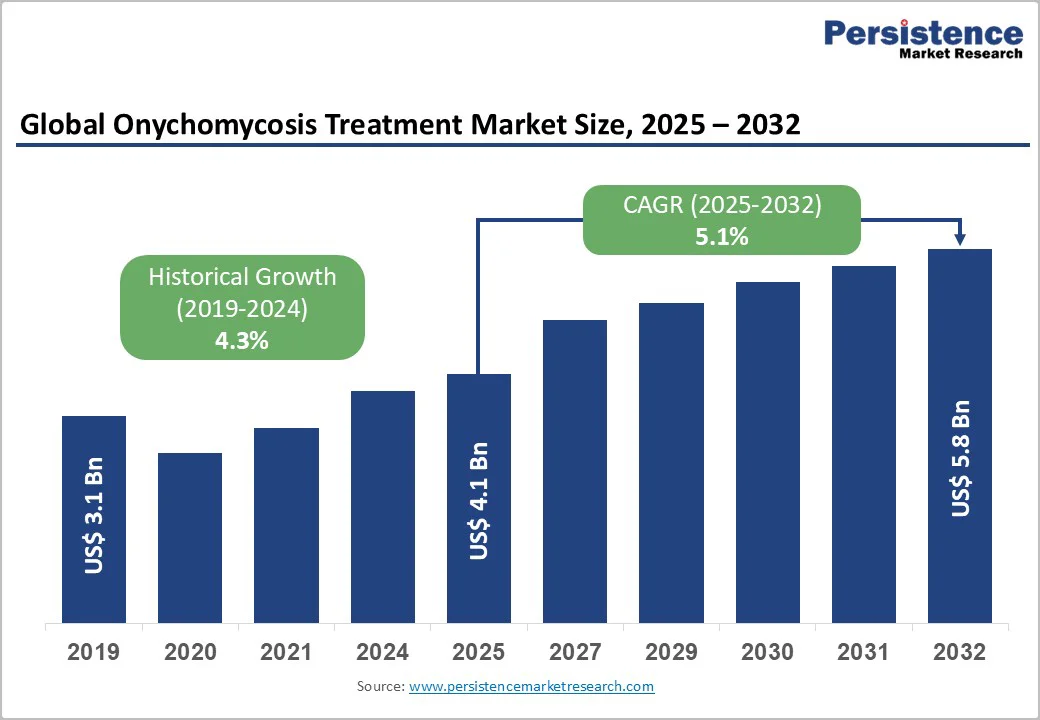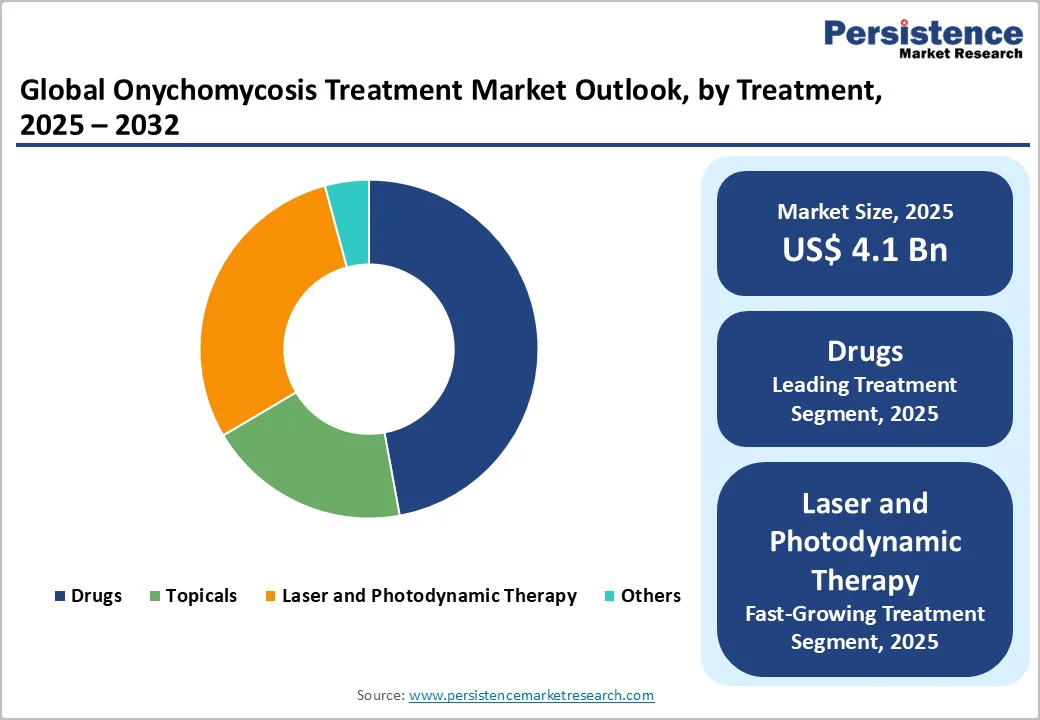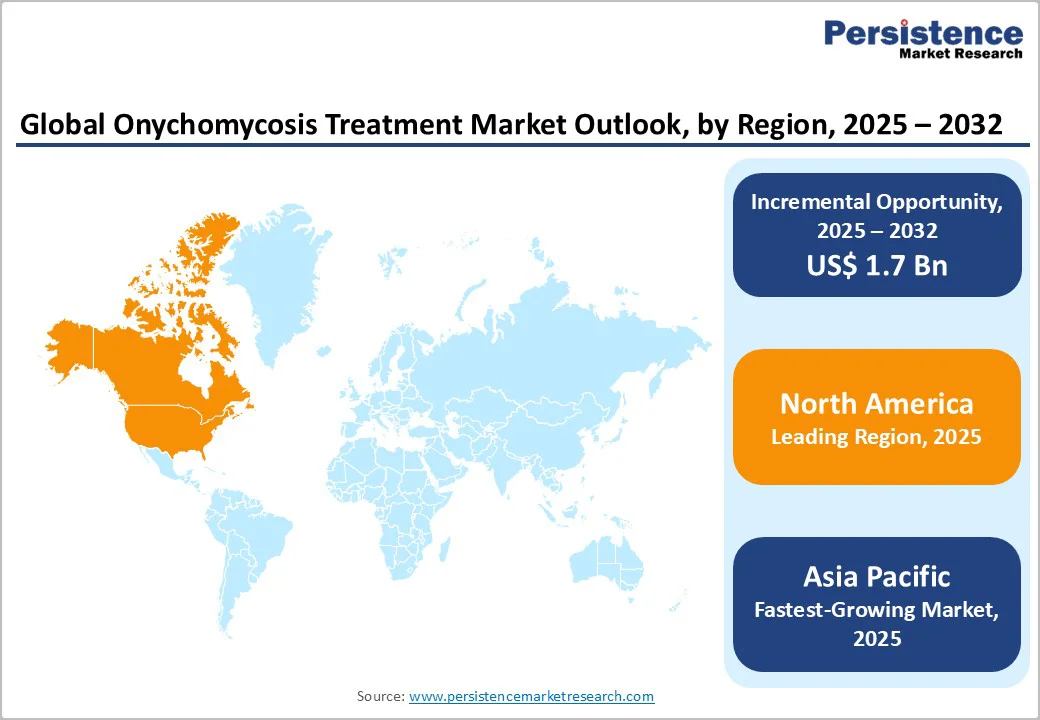ID: PMRREP34004| 188 Pages | 24 Nov 2025 | Format: PDF, Excel, PPT* | Healthcare

The global onychomycosis treatment market size is likely to be valued at US$ 4.1 billion in 2025, and is projected to reach US$ 5.8 billion by 2032, growing at a CAGR of 5.1% during the forecast period 2025-2032. Global demand for onychomycosis treatment is increasing as pharmaceutical, and dermatology companies focus on developing more effective topical, oral, and device-based antifungal solutions. Rising infection rates among diabetic, elderly, and immunocompromised populations, coupled with growing awareness of early diagnosis and cosmetic nail restoration, are fueling market growth. Advancements such as enhanced drug delivery systems, laser therapies, and next-generation formulations, along with expanding access to dermatology care in emerging markets, are further accelerating treatment adoption and strengthening overall market expansion.
| Key Insights | Details |
|---|---|
| Onychomycosis Treatment Market Size (2025E) | US$ 4.1 Bn |
| Market Value Forecast (2032F) | US$ 5.8 Bn |
| Projected Growth (CAGR 2025 to 2032) | 5.1% |
| Historical Market Growth (CAGR 2019 to 2024) | 4.3% |

The growing adoption of advanced topical and oral antifungal therapies is driving market growth through newer formulations that deliver higher clinical cure rates, shorter treatment durations, and improved patient compliance. Innovations including enhanced nail penetration technologies, lipid-based delivery systems, and oral drugs with reduced hepatotoxicity are making treatment more effective and safer for long-term use. Next-generation topical solutions with improved absorption and fewer side effects are increasing patient preference for non-invasive treatment options. For example, in January 2024, Vanda Pharmaceuticals Inc. received FDA approval to proceed with its investigational new drug application for VTR-297, a promising topical antifungal candidate for onychomycosis treatment, reflecting the ongoing shift toward advanced, patient-friendly therapies and boosting the broader demand for the treatment.
The global burden of onychomycosis is rising due to multiple interconnected factors. An aging population, higher diabetes incidence, and growing numbers of immunocompromised individuals are expanding the patient base at risk. Age-related reduced nail growth, peripheral vascular issues, and weakened immunity make seniors more susceptible to fungal nail infections. Diabetic patients face a significantly higher risk compared to the general population. Lifestyle factors such as frequent use of occlusive footwear, increased sports participation, and communal exposure in gyms and swimming facilities further elevate infection rates and fuel treatment demand.
Treatment of onychomycosis often takes several months, with the duration typically ranging from six to twelve months depending on nail growth and how severe the infection is. However, even after finishing treatment, fungal nail infections frequently return. Recurrence rates can be as high as 20% to 50%, mainly because completely eliminating the fungus is challenging. Other factors such as poor drug absorption and the risk of reinfection through contaminated shoes or environments also contribute. These lengthy and repeated treatment processes make it harder for patients to stick with their medications and lead to higher healthcare costs. As a result, a large number of people avoid seeking treatment early or drop out before recovering.
The way onychomycosis is diagnosed varies greatly depending on location. Some areas rely on simple techniques such as microscopic examination, while others use more advanced approaches such as polymerase chain reaction (PCR) or lab culture tests. This lack of consistency leads to frequent misdiagnosis and false negative results. In places with limited access to advanced testing, especially in low- and middle-income countries, accurately identifying the specific fungus is often delayed or missed. This delays treatment and sometimes results in the wrong therapy or untreated cases, making it harder for people to get the care they need. Ultimately, these diagnostic challenges slow down timely treatment and hold back overall market growth for effective antifungal solutions.
The way people treat onychomycosis is changing gradually. Patients and doctors are increasingly turning to device-based therapies and non-drug treatments instead of traditional antifungal medications. These newer approaches are becoming popular because they help avoid problems like drug resistance, liver damage, and the long waiting periods needed for oral and topical drugs to work. One example is BiaCure Therapies, a company developing non-invasive medical technology for fungal nails. In 2025, the company received funding to continue developing its high-frequency energy therapy system for onychomycosis treatment. This funding supports testing the treatment's effectiveness, improving the product, and moving it through regulatory approval. The investment shows that both government agencies and industry leaders believe device-based, drug-free solutions are important and have real potential. These advanced technologies aim to give patients better results than standard antifungal medications.
At the same time, more people are choosing over-the-counter (OTC) and plant-based antifungal options. These products appeal to those who want to avoid chemicals and manage their treatment at home with fewer side effects. Herbal formulations, essential oil products, and natural nail serums are becoming more popular, especially among people with mild to moderate infections who prefer treatments they can buy without a prescription at lower costs. This growing interest is creating opportunities for companies to develop natural therapies with scientific backing, combination treatment kits, and OTC products sold online. These options target health-conscious consumers looking for safer, more natural ways to treat fungal nails.
Drugs are the leading treatment approach for onychomycosis and are projected to remain dominant in the global market in 2025. Oral and topical antifungal drugs serve as the first-line treatment option for most patients because they are widely available and relatively easy to access. These medications have strong prescription volumes and often require extended treatment periods, making them the backbone of fungal nail infection management. Newer drug formulations have significantly improved over recent years, offering better penetration into the nail bed where fungi live and causing fewer side effects than older treatments. These advanced medications also reduce the likelihood of infection recurring after treatment ends, which encourages both patients and doctors to choose drug-based approaches.
Beyond improved formulations, several factors continue to strengthen the preference for medication-based treatment. Patient awareness about fungal nail infections has grown substantially, making more people recognize symptoms and seek treatment. Retail pharmacies now stock a wider variety of antifungal products, making treatments more convenient to obtain. The expansion of generic antifungal drugs has made these medications more affordable for patients, removing a significant barrier to treatment access. For several patients and healthcare providers, pharmacological treatment remains the most practical, cost-effective, and trusted option for managing onychomycosis compared to newer or invasive alternatives.
Distal subungual onychomycosis is the most common type of fungal nail infection seen worldwide and holds the largest portion of the onychomycosis treatment market revenue share in 2025. This form of infection starts at the nail tip and spreads toward the base, making it easier for doctors to spot and diagnose compared to other types of fungal nail infections. People with diabetes face significantly higher risk of developing this type of infection because high blood sugar weakens the immune system and slows healing. Older adults are also more vulnerable due to age-related changes in nail growth and reduced circulation.
Since distal subungual onychomycosis develops gradually and often becomes a chronic condition, patients typically require extended treatment periods. Many need weeks or months of continuous therapy using oral medications, topical products, or combinations of both approaches. This prolonged treatment need directly increases market demand and revenue for antifungal medications and ongoing medical care. The combination of high prevalence, ease of diagnosis, and chronic nature of the disease makes this segment consistently strong in the treatment market.
Hospitals play a central role in onychomycosis treatment delivery and are expected to remain the dominant setting for patient care in 2025. They attract higher patient volumes, especially those with severe infections that need specialized evaluation and advanced treatment options. Hospital dermatology and podiatry departments provide expert diagnosis, ruling out other conditions that might mimic fungal infections. For complex or resistant cases, hospitals offer advanced treatments such as combination drug therapy, laser therapy, and surgical nail removal that are not available in typical outpatient settings.
Hospitals also serve as the primary care destination for vulnerable patient populations who need close medical monitoring. Patients with diabetes require regular follow-up to prevent complications from fungal infections, which can lead to serious foot problems. Older adults benefit from coordinated care where doctors monitor both the fungal infection and any related health conditions. Insurance coverage typically favors hospital-based treatment, and access to on-site laboratory testing for accurate diagnosis strengthens the appeal of hospital care. The presence of qualified specialists, comprehensive facilities, and ability to manage severe cases make hospitals the preferred setting where patients receive professional treatment, follow-up care, and monitoring for optimal outcomes.

North America is expected to lead the onychomycosis treatment market share, with the United States driving significant growth. The U.S. market benefits from high awareness of fungal nail infections, strong healthcare spending, and widespread access to prescription antifungal medications and advanced treatments such as laser therapies. The region has a well-established dermatology infrastructure with specialists who diagnose and treat fungal infections regularly. Pharmaceutical companies invest heavily in research and development to bring new treatments to market, and many offer patient assistance programs to make medications affordable. The regulatory environment supports rapid approval of new antifungal therapies, and healthcare providers increasingly prefer newer topical and oral formulations proven effective through clinical studies.
Demographic and health trends in North America have created a sustained demand for fungal nail infection treatment. The aging population faces increased vulnerability due to slower nail growth, weaker immunity, and reduced blood circulation that make infections more likely to develop and persist. Older adults often need extended treatment periods and ongoing care to manage the condition effectively. Diabetes is increasingly common in North America, and people with diabetes are at much higher risk for fungal nail infections due to poor circulation and reduced healing ability. These patients often experience chronic infections that require long-term antifungal therapy, specialist consultations, and preventive care strategies.
Europe represents a steady and growing market for onychomycosis treatment, backed by strong clinical evidence and physician confidence in modern antifungal therapies. Healthcare providers prioritize evidence-based treatment approaches backed by rigorous clinical research and successful regulatory approvals of advanced antifungal drugs. Patient attitudes toward fungal nail infections have shifted significantly as people increasingly recognize that these infections affect health, appearance, and quality of life, motivating them to seek professional medical treatment. Early detection and treatment prevents progression to more severe stages that are harder to manage. Healthcare systems across Europe are expanding dermatology and podiatry services to meet growing demand, with Germany, France, Italy, and the U.K. investing in improved diagnostic laboratories and making newer antifungal medications more widely available.
The disease burden in Europe continues to rise, particularly among vulnerable populations. Diabetes affects millions of Europeans and significantly increases the risk of fungal nail infections that become chronic and difficult to treat. Peripheral vascular disease, which reduces blood flow to the feet, is another common condition that makes people susceptible to persistent fungal infections. These patients require long-term monitoring, ongoing treatment, and preventive measures to avoid serious complications. The combination of aging populations, rising chronic disease prevalence, and improved access to specialist care and modern medications supports steady market growth across Europe.
Asia Pacific is experiencing rapid market growth, as diabetes rates are climbing across the region, particularly in India and China, where economic development has spiked the incidence of lifestyle-induced diseases. The tropical and subtropical climates in Southeast Asia, India, and other parts of the region create ideal conditions for fungal infections to develop and spread, making fungal nail infections more common. The aging population in the developed economies of Japan and South Korea face higher infection risk due to slower nail growth and weakened immune systems. Patient awareness about fungal nail disorders has grown significantly as healthcare information becomes more accessible, leading more patients to seek professional care.
Healthcare access is expanding dramatically across Asia Pacific through growth in both public and private dermatology and podiatry services. More affordable topical and oral antifungal medications are becoming available as generic drugs enter the market and local manufacturers increase production. International pharmaceutical companies are establishing partnerships and local manufacturing operations to serve the growing patient population. Medical tourism is becoming an important factor as patients travel to receive specialized care in countries known for advanced healthcare. The entry of international pharmaceutical brands, expansion of private healthcare infrastructure, and increasing availability of effective medications support strong and sustained market growth in Asia Pacific.

The global onychomycosis treatment market is highly competitive, with major players such as Pfizer, Dr. Reddy's Laboratories, Novartis, Galderma Laboratories, and GlaxoSmithKline dominating through diversified antifungal drug portfolios, strong geographic presence, and continuous product innovation. These companies are focusing on developing next-generation topical and oral antifungals with improved safety, faster cure rates, and enhanced nail penetration.
Strategic initiatives including product licensing, R&D partnerships, and acquisitions of dermatology-focused firms are helping companies widen treatment pipelines and accelerate regulatory approvals. Moreover, growing investments in laser-based therapies, patient-friendly formulations, and digital adherence platforms are strengthening competitive positioning and supporting long-term market expansion.
The global onychomycosis treatment market is projected to reach US$ 4.1 billion in 2025.
Rising prevalence of fungal nail infections among diabetic, elderly, and immunocompromised populations, along with increasing demand for faster, more effective topical, oral, and device-based antifungal therapies are driving the market.
The market is poised to witness a CAGR of 5.1% between 2025 and 2032.
Rising demand for non-invasive laser and photodynamic therapies, growing consumer shift toward OTC and natural antifungal products, and increasing R&D investments in next-generation topical and oral formulations are creating significant growth opportunities.
Pfizer Inc., Dr. Reddy's Laboratories, Novartis AG, Galderma, and GSK are some of the key players in the market.
| Report Attribute | Details |
|---|---|
| Historical Data/Actuals | 2019 – 2024 |
| Forecast Period | 2025 – 2032 |
| Market Analysis | Value: US$ Bn/Mn, Volume: As Applicable |
| Geographical Coverage |
|
| Segmental Coverage |
|
| Competitive Analysis |
|
| Report Highlights |
|
By Treatment
By Disease
By End-User
By Region
Delivery Timelines
For more information on this report and its delivery timelines please get in touch with our sales team.
About Author